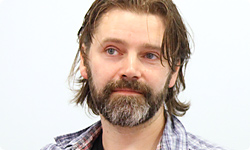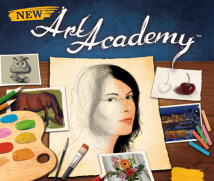4. The Importance Of Observation
I’d imagine you spent a lot of time discussing how best to make use of the functionality of Nintendo 3DS.
Yes, we did. During the development of this title, a major challenge we faced was how to make effective use of the 3D capabilities of the system. We decided to use the 2D lower screen as a canvas, in the same way as we did before, while the upper screen allows you to view the subject of your painting in three dimensions. After all, when you draw a picture, such as a still life, a landscape or a portrait, you’ll generally be drawing something that was originally in three dimensions, and recreating these images on a flat surface.
So this works perfectly on Nintendo 3DS.
Yes, it does. When you draw or paint a picture, the really important thing is not how you move your hand, but rather it’s whether or not you spend time properly observing the subject of your picture.
So it’s important to sit and look at the subject you wish to paint and really understand it.
Right. So I realised that you could use the upper screen of the Nintendo 3DS system to rotate the subject of your picture and observe it, or you could adjust the light, meaning that you’re doing exactly what an artist does when he observes a model or landscape.
By observing your subject from different angles and adjusting the light, you can really gain a deeper understanding of it, which will help you to create a better picture.

But it was a real challenge sourcing the 3D images to use in the lessons, wasn’t it?
Yes, it was. There are hardly any resources available for 3D photography, meaning you can’t just pay for the licence to use certain photographs. Instead, we had to take most of them ourselves.
Tancred actually went on a holiday specifically to take pictures.
Hey! That wasn’t a holiday! (laughs)
(laughter)
Though I’m not sure all my colleagues would agree... (laughs) In any case, I thought about where in the United Kingdom I would be able to take pictures of typical European landscapes, and concluded that I should go to Wales.
Wales is in the west of the United Kingdom, and has large areas of unspoiled natural beauty, doesn’t it?
Yes, that’s right. I hired a cameraman to take 3D photographs and we went on a trip for four or five days. We worked to a really tight schedule, so we’d be in the middle of a river one moment, and dangling from a cliff the next, but we did manage to take all kinds of pictures.
It really doesn’t sound like the work a producer from a video game company should be doing! (laughs)
Indeed not! (laughs)
Tancred is actually an outdoors type of guy, and loves getting out and going hiking.
Ah, is that right?
Yes. It was a trip I found really exciting. I remember we came across a pony as we were driving and without a second’s hesitation, we were out of the car, taking photos.
Here’s the pony .
So its tail and head are both moving.
In this title, there is a lesson where you draw what you see in a video.
In the real world, it’s very rare that you will get to draw something that’s completely motionless.
Yes, that’s right. That’s why we decided to include some moving images to draw. If you go outside to sketch a scene, the clouds will be moving, the leaves will be rustling, and the light will be changing. This is something that proves initially challenging for a lot of people.
So you included a video in one of the lessons so that people could experience drawing something that was closer to real life.
That’s correct.
There are also images of people... Here’s one now.
Ah, I see that the image of the boy is rotating .
Tancred, you used a swivel chair to take these images, didn’t you?
That’s right. It was just like the chair I’m sitting in now. I took the photos while changing the angle of the seat. (Tancred turns in his seat as he says this)
(laughter)
That made it possible to observe someone from a variety of angles.
You can rotate the model, but you can also rotate the lighting, isn’t that right?
Yes.
By adjusting the angle of the lights, the shadows will give you a better sense of perspective.
Adjusting the lighting can have two meanings. The first is to adjust the angle that the light falls on the subject to allow you to draw a picture that presents them in the most flattering way. The other is to adjust the light source itself in order to gain a deeper understanding of the form, texture and shape of the subject. So I think that this time round you can learn a lot more when compared to the last title where you simply copied flat images.

So up until now you would have had a two-dimensional image that you would copy, whereas with this title, the experience is much closer to that of drawing something in the real world.
That’s right. We’ve been able to enhance the element of observation, which art teachers lay so much importance on. So you’re not simply copying a flat picture or photograph, but are instead much closer to drawing the world as it actually is.
